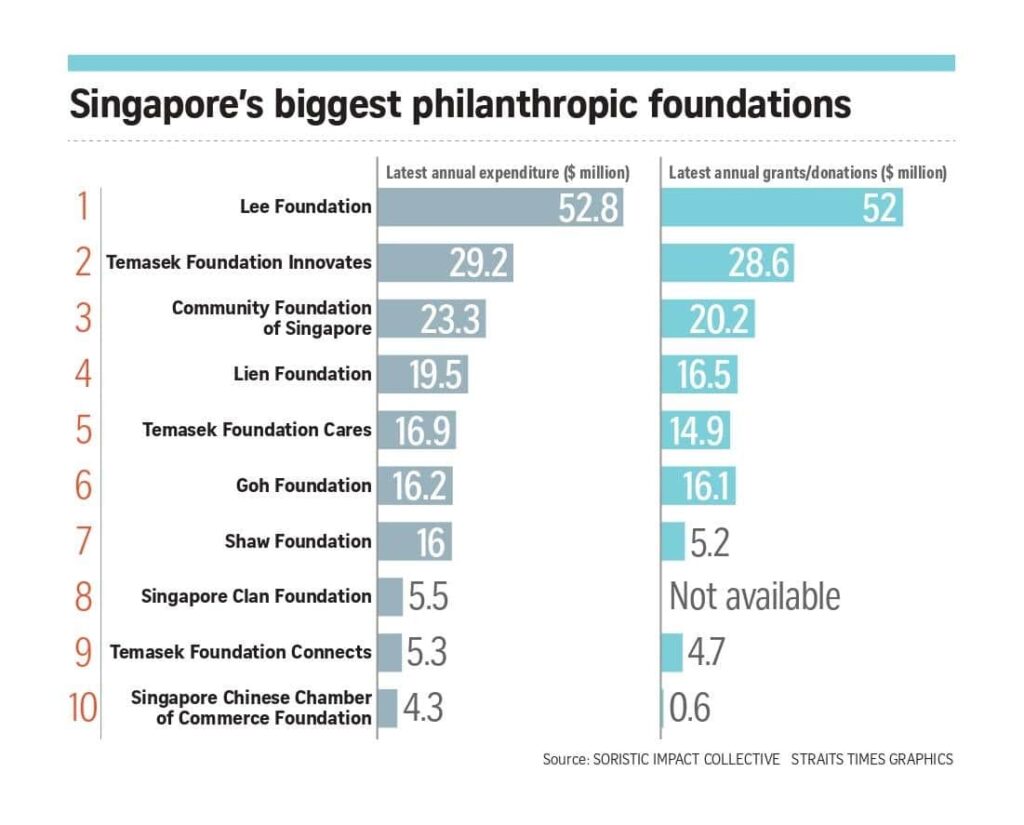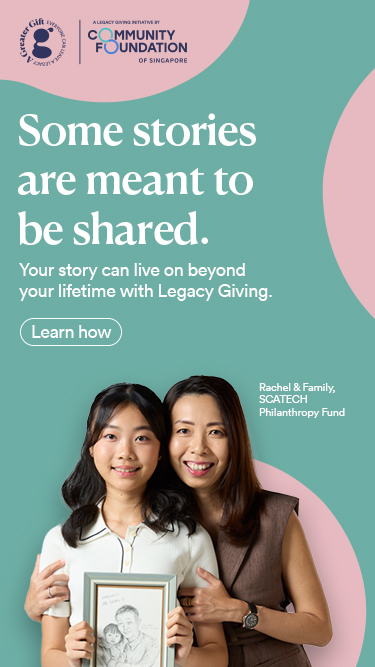CFS is 3rd largest philanthropic foundation in Singapore


They were immigrants who became titans of industry and philanthropists in their own right. Now the legacies endowed by and named for some of Singapore’s richest tycoons – the Lee, Lien and Shaw foundations – continue to be some of the biggest givers to charity here.
All three were among Singapore’s 10 largest philanthropic foundations, according to a report released last month.
The report found that the 10 spent a total of $189 million in their latest financial year to support a range of causes, from community service to education, to disaster relief.
The study by Soristic Impact Collective, a consultancy firm, said the Lee Foundation, founded by the late rubber tycoon Lee Kong Chian in 1952, topped the list.
In its latest financial year, it spent $52.8 million, of which $52 million was given out in grants and donations.
The Lee Foundation is said to give to a wide variety of causes, including education, healthcare and social services.
Temasek Foundation Innovates, one of six Temasek foundations, was second on the list. In its latest financial year, it had an annual expenditure of $29.2 million, of which $28.6 million was given out in grants and donations, according to the report.
Taking third place was the Community Foundation of Singapore, which spent $23.3 million in its latest financial year. Of the sum, $20.2 million was given out in grants and donations.
Donors pledge at least $200,000 to set up a fund with the foundation, which then manages the money, advises donors on various needs in the community and disburses the funds according to the donors’ wishes.
Ms Pauline Tan, principal consultant of Soristic Impact Collective, said the study is the first to rank philanthropic foundations in Singapore by expenditure.
Ms Tan said that countries like the United States and Britain have reports that rank their top philanthropic foundations, but there was no such research in Singapore.
She said: “Thus, we took on the challenge to work on gathering data to bring more transparency into this sector.
“The research will also be useful for charities in Singapore who can potentially use it to know which philanthropic foundations they can approach for funding.”
The consultancy scoured the annual reports and other public documents of foundations registered as charities with the Commissioner of Charities.
It found 91 philanthropic foundations whose work was funded by the founders’ personal wealth or by donations made by the company that set up the foundation.
Among the 91 foundations, 55 were set up by individuals or families and 20 were started by companies. The rest include other set-ups like The Hokkien Foundation and the Community Foundation of Singapore.
About a third of the 91 foundations spent at least $1 million in their latest financial year – this could be from 2018 to last year, depending on the foundation. The rest of the foundations spent less than $1 million.
Ms Tan said the foundations’ expenditure included grants and donations as well as manpower costs and other expenses to carry out the philanthropic work.
The report stated: “Philanthropic giving through foundations is set to grow as more wealthy individuals and companies set up foundations.
“Hence, the influence and role of philanthropic foundations in addressing needs in the community is set to grow.”
To make an impact with your giving, read more here.
This article was originally published in The Straits Times here. Source: The Straits Times © Singapore Press Holdings Limited. Permission required for reproduction.
They were immigrants who became titans of industry and philanthropists in their own right. Now the legacies endowed by and named for some of Singapore’s richest tycoons – the Lee, Lien and Shaw foundations – continue to be some of the biggest givers to charity here.
All three were among Singapore’s 10 largest philanthropic foundations, according to a report released last month.
The report found that the 10 spent a total of $189 million in their latest financial year to support a range of causes, from community service to education, to disaster relief.
The study by Soristic Impact Collective, a consultancy firm, said the Lee Foundation, founded by the late rubber tycoon Lee Kong Chian in 1952, topped the list.
In its latest financial year, it spent $52.8 million, of which $52 million was given out in grants and donations.
The Lee Foundation is said to give to a wide variety of causes, including education, healthcare and social services.
Temasek Foundation Innovates, one of six Temasek foundations, was second on the list. In its latest financial year, it had an annual expenditure of $29.2 million, of which $28.6 million was given out in grants and donations, according to the report.
Taking third place was the Community Foundation of Singapore, which spent $23.3 million in its latest financial year. Of the sum, $20.2 million was given out in grants and donations.
Donors pledge at least $200,000 to set up a fund with the foundation, which then manages the money, advises donors on various needs in the community and disburses the funds according to the donors’ wishes.
Ms Pauline Tan, principal consultant of Soristic Impact Collective, said the study is the first to rank philanthropic foundations in Singapore by expenditure.
Ms Tan said that countries like the United States and Britain have reports that rank their top philanthropic foundations, but there was no such research in Singapore.
She said: “Thus, we took on the challenge to work on gathering data to bring more transparency into this sector.
“The research will also be useful for charities in Singapore who can potentially use it to know which philanthropic foundations they can approach for funding.”
The consultancy scoured the annual reports and other public documents of foundations registered as charities with the Commissioner of Charities.
It found 91 philanthropic foundations whose work was funded by the founders’ personal wealth or by donations made by the company that set up the foundation.
Among the 91 foundations, 55 were set up by individuals or families and 20 were started by companies. The rest include other set-ups like The Hokkien Foundation and the Community Foundation of Singapore.
About a third of the 91 foundations spent at least $1 million in their latest financial year – this could be from 2018 to last year, depending on the foundation. The rest of the foundations spent less than $1 million.
Ms Tan said the foundations’ expenditure included grants and donations as well as manpower costs and other expenses to carry out the philanthropic work.
The report stated: “Philanthropic giving through foundations is set to grow as more wealthy individuals and companies set up foundations.
“Hence, the influence and role of philanthropic foundations in addressing needs in the community is set to grow.”
To make an impact with your giving, read more here.
This article was originally published in The Straits Times here. Source: The Straits Times © Singapore Press Holdings Limited. Permission required for reproduction.
- Related Topics For You: CHARITY STORIES, DONOR STORIES, DONOR-ADVISED FUND, NEWS, PARTNERSHIP STORIES




